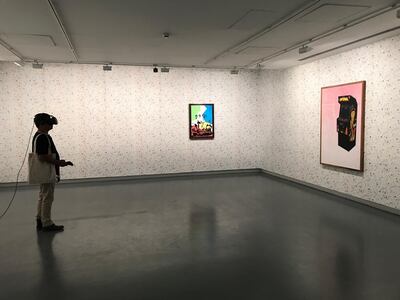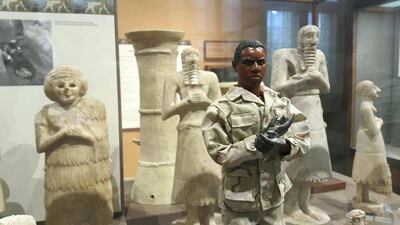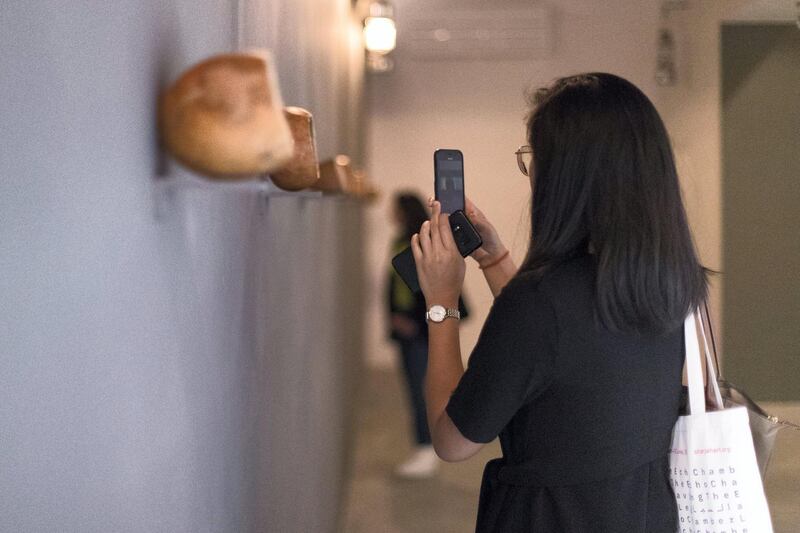The Sharjah Biennial officially opened on Thursday, this year focusing on the topic of how we digest and form opinions today.
Now in its 14th year, the renowned exhibition launched a number of commissions – look out for new work by a hefty list including Lawrence Abu Hamdan, Mohamed Bourouissa, Meschac Gaba, Aline Baiana, Caline Aoun, Tuan Andrew Nguyen, Khadim Ali and Lisa Reihana. There are historical presentations as well, which the biennial has likewise become known for.
Its three separate curators (namely Zoe Butt, Claire Tancons and Omar Kholeif) are varied in terms of stylistic affinities and geographic specialisation, which has ensured a unique and diverse line-up of art.
Here are our top five picks of what to see over the next three months in the emirate.
1. Otobong Nkanga’s spatial and sound performance of a tree addicted to salt water.
Nkanga is a favourite child of the Sharjah Biennial, having participated in several previous years, and her 2019 work is a particular highlight. For SB14, Nkanga joins forces with fellow Nigerian artist Emeka Ogboh for a multimedia installation within the courtyard of Bait Al Aboudi.
Aging Ruins Dreaming Only to Recall the Hard Chisel from the Past was inspired by a dead tree in the courtyard, which Nkanga imagines as a tree who dies from her addiction to salt water. Her whispers resound through the courtyard, which is dotted with circular craters that the artist filled with seawater. Responding to the extreme salination of water here, extra salt has been added to ensure that traces of saline will remain as the water evaporates over time. Nearby, speakers play a range of natural sounds – a recording of an Emirati 'rain song' performed by children in Sharjah and texts conceived from the perspectives of water, earth and trees, written and performed by Nkanga.
This also won the Sharjah Biennial 14 Prize - the event's main prize - on the gala's opening night, so don't miss it.
Where is it? Bait Al Aboudi in the Sharjah heritage area.

2. Anwar Jalal Shemza and the painting show within Sharjah Art Museum
Check out the impressive historical painting show at the Sharjah Art Museum. Starting with works from Pakistani modernist Anwar Jalal Shemza, it includes paintings by Lebanese artist Hugette Caland, whose work has been happily appearing here and there over the past few months in the UAE; paintings by Marwan, the late renowned Syrian artist; the Portuguese painter Bruno Pacheco; Turkey's beloved, postwar painting pioneer Semiha Berksoy; British Turner Prize-winner Lubaina Himid; and British-Pakistani artist Shezad Dawood.
Dawood has created Encroachments, a virtual-reality installation that animates lost memories of Pakistan and touches on the long history of US interference in the country. Dawood won one of the four special mentions for artists in the biennial at the opening night's gala dinner.
Where is it? Sharjah Art Museum.

3. Iraqi-US artist Michael Rakowitz’s 'The Ballad of Special Ops Cody', 2017
Michael Rakowitz has a knack of tying interesting anecdotes and obscure knowledge into political and historical events. The Ballad of Special Ops Cody (2017) is no different; once again highlighting his ability to forge connections between current events, pop culture, migration and diaspora, while working across a range of mediums. The video examines the 2005 incident when an Iraqi insurgent group posted a photo online of a captured US soldier named John Adam, threatening to kill him if US-held prisoners in Iraq were not freed. As the US army scrambled to find out who this lost soldier was, coming up with nothing, it turned out that John Adam did not actually exist. In fact, he was a toy soldier called Special Ops Cody, which was made on military bases in Kuwait and Iraq and sent to the children of active soldiers.
Rakowitz gives life to this toy soldier through a moving stop-motion animation filmed at the University of Chicago’s Oriental Institute, which has had a relationship with the National Museum of Iraq since the 1930s.
Rakowitz made headlines in 2018 for his work The Invisible Enemy Should Not Exist, a replica of an ancient lamassu made of thousands of date syrup cans, commissioned for Trafalgar Square's fourth plinth.
Where is it? Bait Alserkal
4. Phao Thao Nguyen's film about famine in Vietnam
Nguyen is a celebrated multimedia artist who has exhibited widely in her native Vietnam and further afield. She works across painting, installations and ‘theatrical fields’, including what she calls "performance gesture and moving images".
For the Sharjah Biennial she creates a three-channel video about the famine of the 1940s, when children were abandoned in markets because families could not feed them, and whole extended families were decimated. Despite this tough subject matter, the work achieves a lightness and empathy with its subjects throughout.
Where is it? Off Calligraphy Square.
5. Meschac Gaba's extravagant wigs
Market traders at the souq and locals in the Heart of Sharjah were taken by surprise during the biennial's opening days, when a group of performers, wearing tall wigs of hand-braided hair, snaked through the area. It was a procession by the Beninese conceptual artist Meschac Gaba, entitled Perruques Architectures Emirats Arabes Unis, that brought together Gaba's interest in architecture with the local landscape: the wigs resembled famous buildings from the UAE, such as the torqued building in Dubai and the towers of DIFC.
Inspired originally by the hair-braiding salons of Harlem, Gaba has used these wigs to discover major international cities. Visitors to the biennial can now see these new creation in one of the Souq al Shanisiyah shopfronts, where they are (sadly) not for sale.
Where is it? Souq al Shanisiyah, near Bait Obaid Al Shamsi.
_____________________
Read more:
Your essential guide to Dubai Art Season
From soap to algae: UAE artists creating art from everyday items annual exhibit
Sharjah Biennial opens on themes of migration and interconnected histories
_____________________





